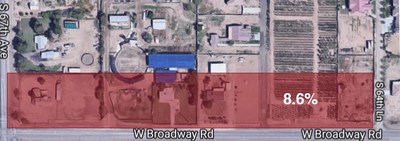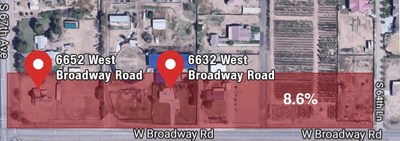Subjects: LAW, LEG
South Dakota v. Wayfair - TTR Explains What Tax Technology Options Really are Available
MCMINNVILLE, Ore., April 19, 2018 /PRNewswire/ -- Currently, the US Supreme Court is considering whether to overrule a decision it reached 25 years ago, Quill v. North Dakota. That decision provided that online retailers are not required to collect a state's sales tax unless the retailer has a "physical presence" in that state. The current case, South Dakota v. Wayfair, arose when South Dakota began requiring Wayfair and other online retailers to collect sales tax even though they did not have a physical presence in the state.
In its arguments before the Supreme Court, South Dakota is taking the position that online retailers should be required collect sales tax because, without such a requirement, (1) physical stores (often called "traditional" or "brick-and-mortar" retailers) are put at a competitive disadvantage by having to collect sales tax, and (2) states are deprived of significant tax revenue.
The taxpayers in the case (Wayfair, Overstock.com, and Newegg), are arguing that online retailers should not be required to collect sales because (1) sales tax collection for online retailers remains complex and burdensome ? a factor in the Court's earlier Quill decision, and (2) South Dakota's estimate of lost revenue is inflated.
What does collecting sales tax really look like in the US?
A challenge with sales tax collection processes and sales tax software is that you can't just go out and look at them. If we were talking about a tractor, we could sit on it, drive it around, and do things with it. Collecting sales tax is a process that involves IT, tax and accounting professionals, software, reams of paper, lots of laws, and more.
To simplify this, there is a high-level, 8-step process for collecting sales tax:
Step One: What am I selling?
Step Two: Where does the sale take place?
Step Three: Does sales tax apply to my sale?
Step Four: If what I'm selling is taxable, what is the correct sales tax rate at that location?
Step Five: If what I'm selling is taxable, how do I calculate the sales tax?
Step Six: Once I've calculated the correct sales tax, how do I present this on a customer invoice or receipt?
Step Seven: Once I've correctly charged sales tax to a customer, how do I get that tax to the correct state or local government?
Step Eight: Once I've correctly sent tax to the correct government, what records do I need to keep in case of an audit?
Collecting sales tax correctly is not impossible, but it is time-consuming. This is why so many companies turn to technology solutions for help.
What are the real tax technology options for large, medium-sized, and small retailers in the US?
What is tax technology?
- Tax technology is the use of software to assist with correctly paying sales and use taxes.
What are the real tax technology options in the marketplace?
- There are many tax technology options available today, but what are you really getting with these available options?
To make sense of tax technology options and smartly evaluate the best solution for your company, it is helpful to organize what the tax technology does and does not do based on the 8-step process of collecting sales tax.
Step One: What am I selling?
Tax technology does not help with this. Professionals in the company have to know or learn what they are selling before they can effectively use tax technology.
Step Two: Where does the sale take place?
Tax technology can help with this. Some companies provide lists of geographic locations. They come in many names and forms. For example, "geocodes" typically represent a combination of state, county, and city locations. Tax technology will often use a street address input by the customer for an online sale, and then the tax technology will match that street address to a "geocode" contained in their own system. While this process is pretty accurate, nearly all tax technology providers are only accurate to "ZIP+4" ? which is a ZIP code with 4 extra numbers that represent a "block" or "group" of street addresses. This is not as accurate as connecting a sales tax rate to each address, but very few providers actually do this.
TTR, a sales tax research company based in Oregon, is one of the only providers of address-level sales tax rates in the US. Their sales tax rates connect directly to each street address, not ZIP+4. See Step Four below for an example of why this is important.
Step Three: Does sales tax apply to my sale?
Tax technology companies provide a two-part answer to this question. First, you have to go into their software and find a match to something you are selling. This is called "mapping," or connecting something you sell to an item in their "off the shelf" or "canned" list of about 2,000 or 3,000 "things." Second, you have to set this up in their software. This is usually called "configuration," or setting up the tax rules for your company.
TTR has just over 100,000 items available to map or connect to ? making TTR's list of items the most comprehensive list available in the US. TTR also has proprietary artificial intelligence software that initially matches or maps a company's products and services directly to one of TTR's over 100,000 available items. This makes Step One more automatic and less manual.
Step Four: If what I'm selling is taxable, what is the correct sales tax rate at that location?
As mentioned previously (in Step Two), tax technology companies nearly all use ZIP+4 to calculate or give a customer a sales tax rate. While this is accurate in most cases, in nearly every state in the US, it results in mistakes. Take the following example in Arizona:
The area highlighted in image A is an actual ZIP+4 zone in Phoenix, Arizona (85043-6508). (See image A.)

If a business used ZIP+4 to find the sales and use tax rate, it would conclude that the tax rate for every address in the highlighted area, including the two addresses marked below, is 8.6%. However, that would be incorrect. (See image B.)

The address on the right (6632 West Broadway Road) is outside the city limits and has a lower sales tax rate. TTR's Rooftop Rates does not use ZIP+4, so it does not make this mistake. Instead, it relies on proprietary custom-drawn maps. With TTR's Rooftops Rates, the sales tax rate would appear as follows. (See image C.)

Step Five: If what I'm selling is taxable, how do I calculate sales tax?
Tax technology providers do this very well. Tax calculation software works uniformly well when it receives a correct location, tax answer, and tax rate. Companies like Vertex, Sovos, and TTR are some of the solution providers in this area.
Step Six: Once I've calculated the correct sales tax, how do I present this on a customer invoice or receipt?
Billing presentation rules or laws vary from industry to industry and state to state. For most online retailers, simply presenting a line on the invoice labeled "sales tax" is correct and sufficient for "truth in billing" rules or laws.
Step Seven: Once I've correctly charged sales tax to a customer, how do I get that tax to the correct state or local government?
Tax technology solutions often have reporting capabilities ? meaning the software allows you to export information out of the system to prepare and file tax returns to the government. Each solution has different reporting capabilities. Many also offer software to assist companies in preparing and filing tax returns.
Step Eight: Once I've correctly sent tax to the correct government, what records do I need to keep in case of an audit?
Most states require that records be kept 3 to 5 years, depending on the state.
Conclusion
The above overview is far from complete, but hopefully provides a bit of simplicity and understanding to a complex area. There are other issues to address, such as who is selling and buying and whether they are exempt because of their type of business, isolated or occasional sale rules, and many other factors that can impact whether something should include sales tax.
Whether you are for or against requiring online retailers to collect sales tax, one thing we can probably all agree on is that collecting sales tax correctly, even with tax technology, is challenging for companies of all sizes. So the next time you meet a sales tax professional, give them a hug. They deserve it.
Who is TTR and what do they do?
TTR is The Tax Answer Companytm. TTR has over 10,000 companies using their revolutionary online tax research platform. TTR's team of 100 professionals reads tax laws and determines whether sales tax should be applied to over 100,000 products and services that can be sold in the US. TTR also provides address-level accurate sales and use tax rates (often called Rooftop Rates). TTR also provides an artificial intelligence (A.I.) enabled Exemption Certificate Management System (ECMS) that can tell your company whether the certificates it sends and receives are valid. TTR also provides the only A.I. enabled "mapping" software in the US. TTR also provides tax automation software to automatically apply sales or use tax to transactions for your company. TTR's vision is to improve the quality of people's lives. Contact them today to find out how they can do just that for your company.
If you'd like to find out more about TTR, please email [email protected] or call 971-261-6006.
SOURCE Transaction Tax Resources
These press releases may also interest you
|
News published on and distributed by:



